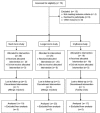In Vivo skin hydration and anti-erythema effects of Aloe vera, Aloe ferox and Aloe marlothii gel materials after single and multiple applications
- PMID: 24991119
- PMCID: PMC4078333
- DOI: 10.4103/0973-1296.133291
In Vivo skin hydration and anti-erythema effects of Aloe vera, Aloe ferox and Aloe marlothii gel materials after single and multiple applications
Abstract
Objective: To investigate the skin hydrating and anti-erythema activity of gel materials from Aloe marlothii A. Berger and A. ferox Mill. in comparison to that of Aloe barbadensis Miller (Aloe vera) in healthy human volunteers.
Materials and methods: Aqueous solutions of the polisaccharidic fractions of the selected aloe leaf gel materials were applied to the volar forearm skin of female subjects. The hydration effect of the aloe gel materials were measured with a Corneometer(®) CM 825, Visioscan(®) VC 98 and Cutometer(®) dual MPA 580 after single and multiple applications. The Mexameter(®) MX 18 was used to determine the anti-erythema effects of the aloe material solutions on irritated skin areas.
Results: The A. vera and A. marlothii gel materials hydrated the skin after a single application, whereas the A. ferox gel material showed dehydration effects compared to the placebo. After multiple applications all the aloe materials exhibited dehydration effects on the skin. Mexameter(®) readings showed that A. vera and A. ferox have anti-erythema activity similar to that of the positive control group (i.e. hydrocortisone gel) after 6 days of treatment.
Conclusion: The polysaccharide component of the gel materials from selected aloe species has a dehydrating effect on the skin after multiple applications. Both A. vera and A. ferox gel materials showed potential to reduce erythema on the skin similar to that of hydrocortisone gel.
Keywords: Aloe ferox; Aloe marlothii; Aloe vera; Anti-erythema; herbs; skin hydration.
Conflict of interest statement
Figures







Similar articles
-
In vitro wound healing and cytotoxic activity of the gel and whole-leaf materials from selected aloe species.J Ethnopharmacol. 2017 Mar 22;200:1-7. doi: 10.1016/j.jep.2017.02.017. Epub 2017 Feb 14. J Ethnopharmacol. 2017. PMID: 28229920
-
Skin permeation enhancement effects of the gel and whole-leaf materials of Aloe vera, Aloe marlothii and Aloe ferox.J Pharm Pharmacol. 2015 Jan;67(1):96-106. doi: 10.1111/jphp.12311. Epub 2014 Sep 5. J Pharm Pharmacol. 2015. PMID: 25196486
-
Final report on the safety assessment of AloeAndongensis Extract, Aloe Andongensis Leaf Juice,aloe Arborescens Leaf Extract, Aloe Arborescens Leaf Juice, Aloe Arborescens Leaf Protoplasts, Aloe Barbadensis Flower Extract, Aloe Barbadensis Leaf, Aloe Barbadensis Leaf Extract, Aloe Barbadensis Leaf Juice,aloe Barbadensis Leaf Polysaccharides, Aloe Barbadensis Leaf Water, Aloe Ferox Leaf Extract, Aloe Ferox Leaf Juice, and Aloe Ferox Leaf Juice Extract.Int J Toxicol. 2007;26 Suppl 2:1-50. doi: 10.1080/10915810701351186. Int J Toxicol. 2007. PMID: 17613130 Review.
-
Investigation of the anti-inflammatory potential of Aloe vera gel (97.5%) in the ultraviolet erythema test.Skin Pharmacol Physiol. 2008;21(2):106-10. doi: 10.1159/000114871. Epub 2008 Feb 5. Skin Pharmacol Physiol. 2008. PMID: 18253066 Clinical Trial.
-
Review on the phytochemistry and toxicological profiles of Aloe vera and Aloe ferox.Futur J Pharm Sci. 2021;7(1):145. doi: 10.1186/s43094-021-00296-2. Epub 2021 Jul 21. Futur J Pharm Sci. 2021. PMID: 34307697 Free PMC article. Review.
Cited by
-
Antioxidant, anti-inflammatory, anti-apoptotic, and skin regenerative properties of an Aloe vera-based extract of Nerium oleander leaves (nae-8(®)).Clin Cosmet Investig Dermatol. 2015 May 6;8:239-48. doi: 10.2147/CCID.S79871. eCollection 2015. Clin Cosmet Investig Dermatol. 2015. PMID: 26005354 Free PMC article.
-
Aloe vera-Based Hydrogels for Wound Healing: Properties and Therapeutic Effects.Gels. 2023 Jul 3;9(7):539. doi: 10.3390/gels9070539. Gels. 2023. PMID: 37504418 Free PMC article. Review.
-
Topographical diversity of common skin microflora and its association with skin environment type: An observational study in Chinese women.Sci Rep. 2017 Dec 22;7(1):18046. doi: 10.1038/s41598-017-18181-5. Sci Rep. 2017. PMID: 29273721 Free PMC article.
-
Biologically Active Compounds in Stizolophus balsamita Inflorescences: Isolation, Phytochemical Characterization and Effects on the Skin Biophysical Parameters.Int J Mol Sci. 2021 Apr 23;22(9):4428. doi: 10.3390/ijms22094428. Int J Mol Sci. 2021. PMID: 33922647 Free PMC article.
-
Aloe vera-An Extensive Review Focused on Recent Studies.Foods. 2024 Jul 8;13(13):2155. doi: 10.3390/foods13132155. Foods. 2024. PMID: 38998660 Free PMC article. Review.
References
-
- Lee SK. Overview of Aloe study. In: Park YI, Lee SK, editors. New perspectives on Aloe. New York: Springer; 2006. pp. 1–5.
-
- Steenkamp V, Stewart MJ. Medicinal applications and toxicological activities of Aloe products. Pharm Biol. 2007;45:411–20.
-
- Loots D, Van Der Westhuizen FH, Botes L. Aloe ferox leaf gel phytochemical content, antioxidant capacity and possible health benefits. J Agric Food Chem. 2007;55:6891–6. - PubMed
-
- Kim YS. Carbohydrates. In: Park YI, Lee SK, editors. New perspectives on Aloe. New York: Springer; 2006. pp. 57–62.
-
- Reynolds T, Dweck AC. Aloe vera leaf gel: A review update. J Ethnopharmacol. 1999;68:3–37. - PubMed
LinkOut - more resources
Full Text Sources
Other Literature Sources
